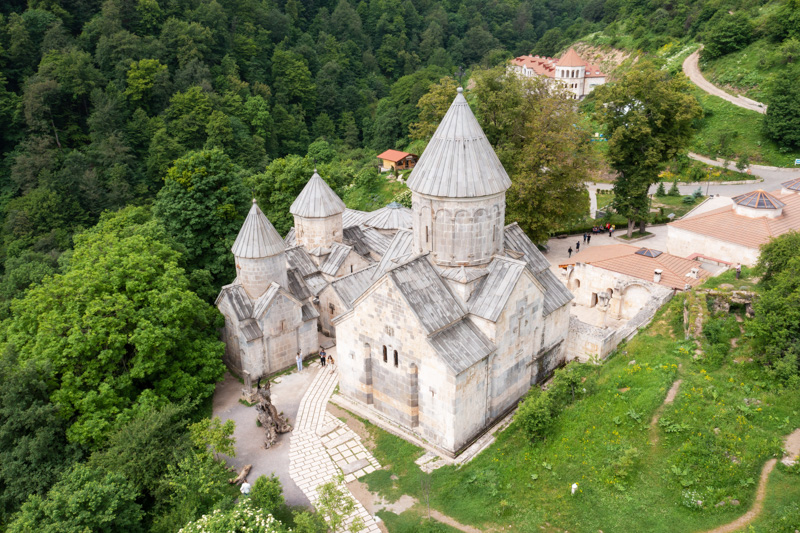Haghartsin monastery complex

Haghartsin is one of the most important historical and cultural attractions not only in the Tavush region but in Armenia. This is the largest monastery complex in the Dilijan National Park. It is located 12 km east of Dilijan in a picturesque forested gorge, near the village of the same name.
Nestled within the upper reaches of the river bearing its name (a tributary of the Agstev), the monastery lies 18 km away from Dilizhan. Its expanse encompasses the medieval complex, featuring the St. Gregory Church (11th century), the St. Astvatsatsin Church (1281), the St. Stepanos Church (1244), a 13th-century chapel, the Bagratids' tomb (12th century), the refectory (1248), and sundry structures erected in the 12th to 13th centuries.
The exact date of the foundation of the monastery complex has not been determined. Currently, the complex includes 4 churches (St. Gregory, St. Stepanos, St. Mother of God, and the Church of Katoghike), built in different historical periods, two narthexes, and a refectory. It is believed that the oldest building of the complex, the Church of St. Gregory, was built in the XI century. It’s built of roughly processed yellow limestone and is a cross-domed structure.
The Church of St. Stepanos is a few meters east of the Church of St. Gregory (dating from 1244). It’s a small building of blue basalt, it’s not distinguished by an excess of details, except for the sundial on the south facade and narrow ornamented windows in the center of the walls and tromps.
The most ancient building within the Haghartsin complex is the St. Gregory church, dating back to the 11th century. Constructed by monks fleeing persecution in Western Armenia under Byzantine rule, this rectangular church is modest in size. Inside, it features a cross-shaped layout, while its exterior is distinguished by a cone-shaped dome atop an octahedral drum. Towards the late 12th century, a small churchlet made of blue basalt, adorned with vaulted arches and a designated space for prayers and burials, was appended to the original structure.The main church of the monastery complex is the Church of the Holy Mother of God (Surb Astvatsatsin). It is located in the northern part of the complex, somehow detached from the complex.
According to some sources, the church was founded in 1281 by the prominent medieval architect Minas. However, the inscription on the tympanum takes us to an earlier time, 1071.
The Church of the Holy Mother of God repeats the pattern of cross-domed structures of the XI-XIII centuries. It stands out for its grandeur of form and exquisiteness of details. This is how architect H. Vatinyan and historian S. Yesayan described the church in the book “Historical and architectural monuments of Dilijan”.
“The slender volume of the church is crowned with a high cylindrical drum of the dome, finished with decorative arcature. There are two triangular niches on all walls, except for the western one. They have niches with festoons similar to the main church of the Geghard Monastery. The narrow windows on the western and northern facades are richly decorated. On the eastern facade, above the twin window, there is a bas-relief of ktetors, there are two large-headed squat figures in monastic attire. They are made to their full height, and they point with their hands at the church model between them, which has somehow enlarged proportions”.
Special attention should be paid to the refectory built in 1248 by the architect Minas, whose name is modestly carved on the vault of the western half of the building. In the architecture of the refectory, Armenian architects used new, creative approaches, since they were not afraid of solemn forms.
The etymology of the word "haghartsin" goes back to the word “only-begotten" (“hagh” - whole, only, “tsin” - birth). However, other versions of the origin of the name of the monastery are also widespread among the people. Thus, according to another version the name of the village is translated as "games of eagles" (“artisvneri khakh”).
Some information about Haghartsin was preserved by the medieval Armenian thinker, Kirakos Gandzaketsi, a student of Mkhitar Gosh. According to Kirakos Gandzaketsi, Haghartsin is inextricably linked with the name of the outstanding medieval thinker and musical figure Khachatur Taronatsi.
In the 13th century, this monastery emerged as the primary hub for spiritual and cultural activities in Armenia. Adjacent to the refectory lie the remnants of a kitchen, while in the vicinity of the monastery, one can observe the vestiges of several chapels. Alongside the southern wall of St. Gregory church, lie the ruins of two tombs belonging to tsars of the Kyurikid dynasty, bearing inscriptions: "Tsar Smbat" and "This is the tomb of Tsar Gagik" (10th - 11th centuries).
“It was under his rectorship that the monastery had its heyday, new buildings of the complex were erected, and a monastic school was opened, where, in addition to theology, secular disciplines, music and singing were taught. This outstanding figure of the Armenian Middle Ages is buried in front of the Katoghike Church,” according to the book “Historical and architectural monuments of Dilijan”.
Any other questions?
Our specialists will contact you as soon as possible




